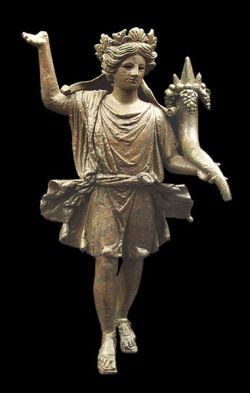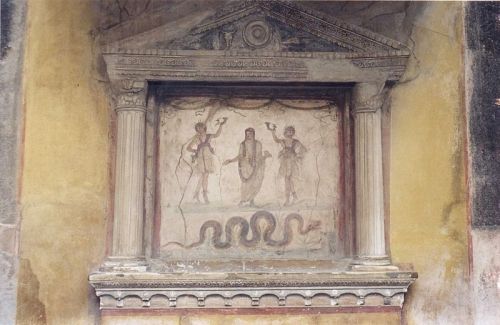Chapters
Many guardian deities were worshipped in Roman families. It was believed that good spirits surround a person from birth. There was a deity of the newborn’s first cry, special deities taught the baby to eat and drink, to lie quietly in bed. Four goddesses were watching his first steps. Each family had its own guardian deities and its own home cult.
The most original cult of the Romans was the cult of genius. As a guardian deity, he was born with a man, he guided his good and bad fortunes. He was shown as a young man in a toga, with his face, goblet and cornucopia covered. On the day of birth (dies natalis) the genius of the master of the house was honoured. Women had one collective genius, Juno, the wife of Jupiter. A deceased man’s genius looked after his family.
The most important were the deities who looked after the house, Janus who guarded the passage against the house where the private thing was in force (res privata) to the public thing (res publica). The interior of the house was guarded by West. Vesta is personified by a donkey.
Penats
The keepers of the house were also Penats (Dii Penates), keepers of the pantry and the hearth, of Etruscan origin. It was the duty of the Romans to sacrifice at the meal; only after finding that the gods had accepted the sacrifice could the supper continue. They were worshipped together with the lares, they were depicted in the form of small figures made of wood, clay, wax, silver or ivory. One day each month was dedicated to them when the statues were decorated with flowers. The penates were sacrificed with wine, incense, fruit, and sometimes also sacrifices of young sheep and goats.
house penates there were also public penates taking care of a given estate or city. The penates of the city of Rome, presented as two seated youths, were to be brought from Troy by Aeneas; the deities sometimes identified with the Dioscors were first kept in the Avalanche and then transferred to the Roman temple of Vesta.
Weddings
Many house ceremonies involved religious ceremonies. Getting married was associated with worshipping the gods of agriculture, for example. The second half of June was considered the most successful period of getting married. On the eve of the wedding, the bride offered her toys and girls’ clothes to the deities. The age limit for marriage was low: boys were 14 and girls were 12. After the wedding feast in the bride’s house, the bride was led to her husband’s house. The wedding procession was accompanied by singing, music and dancing. The young spouse had three coins with her, one of which was to help win the kindness of the local spirits, the second she gave to her chosen one, and the third were sacrificed to Lares.
repotia). The young lady made offerings to the house altar (Lararium), received guests, and finally sat down to the spindles and thus indicated that she was the hostess.
Lares
The deities of the entire family were Lares (Lares, genii loci). They were the souls of the dead, worshipped in Rome as the deities of home and happiness, protecting them from misfortunes. The annual celebration of the Lars – Compitalia was celebrated at street crossings in the city. Larom was erected at the crossroads of the shrines (sacella), which had as many entrances as there were owners lying next to the land. In the shrines (lararia) Lara was placed as doll figure. They were prayed to and sacrifices were made. On weddings, birthdays or when a boy in the family puts on a boule or toga virilis, a feast was organized, during which the doors of the chapels were opened and offerings of cake, wine, and incense were made, the whole thing was decorated with flowers. Against the good souls were evil souls (larvae).
There are many kinds of lares:
- Lares Familiares – the spirits looking after the family and home, in the beliefs of the ancient Romans they were the souls of deceased ancestors who looked after their relatives. Their images stood next to the hearth in the atrium, or in a separate room called Lararium. At the beginning of the meal, you had to make an offering of food to them, and pray to them when leaving or arriving;
- Lares Compitales and Lares Viales – keepers of roads and their crossroads;
- Lares Permarini – protectors against danger at sea;
- Lares Hostilii – defending cities from enemies;
- Lares Rurales – care in the field;
- Lares Militares – care in the army and during the trip;
- Lares Urbani – taking care of the state;
- Lares Publici – over the whole city.
Lemurs
The Romans attached great importance to the form of giving the final service to the dead. It was believed that the ghosts of the dead (lémures) were divided into good (lares) and bad – often the harmful ones were simply identified with lemurs at once. For fear of evil and harmful spirits – larvae, the Romans often visited the tombs of their ancestors, especially on the days of their birth and death and during the feast of the dead (Feralia) on February 21. The father of the family (pater familias) had to protect his home with special magical rites during the nightly festival of Lemuralia on May 9, 11 and 13. The noise made at that time and the sacrifices of black beans were to drive some lemurs out of the house, appease others and favourably set them up. Later during the empire, the image of the ancestral gods was formed – manes (Di Manes). The Romans believed that souls are born with the body that wraps them. The death of the body frees the soul which gains freedom by becoming a lemur. Charitable souls, guarding families and households, freed from the bodies of good people or eudemons, were called laras. The souls of evil people cannot find peace, they are doomed to penance, but their malicious nature rarely allows for a change. The larvae appeared as ghosts or skeletons, sending people fear, nervous diseases and epilepsy. In his philosophical works, Apuleius devoted a lot of attention to demons.
Farewell to the deceased
The body of the deceased was anointed with oils and decorated with flowers and sores. These activities were performed by pollinctor, who cast a wax mask (imago cera) and placed it on the face of the deceased when the body was exposed to the public. The deceased had a coin (obola) put in his mouth to pay for Charon in the afterlife to get the dead across the Styx. Such provision of the deceased for the last journey was called viaticum.
The funeral procession was started by nine musicians, followed by mourners and a group of dancers and actors presenting scenes from the life of the deceased. Further on, on chariots, they rode the leader with the masks of his ancestors on their faces. Before the corpse, there were signs of the positions held by the deceased during his lifetime. The role of the cemetery was played by the roads leading from the city, along which on both sides there were tombs and monumental tombs.
From the mid-5th century BCE, the corpses were usually burned (crematio). Apart from the body, the deceased’s favourite items were placed on the stake. The ashes (ossa) were taken by relatives who put them in a scarf and sprinkled them with wine, milk and spices. If the tomb was not ready yet, the urn with the ashes was kept in the house by making a symbolic funeral by burying the deceased’s finger (cut off before cremation) or by throwing the earth onto the ashes.
After leaving the cemetery, people went to the funeral feast. The mourning period ended on the nineteenth day after the burial. At that time, offerings were made and a feast was arranged next to the monument or directly on the grave of the deceased.









